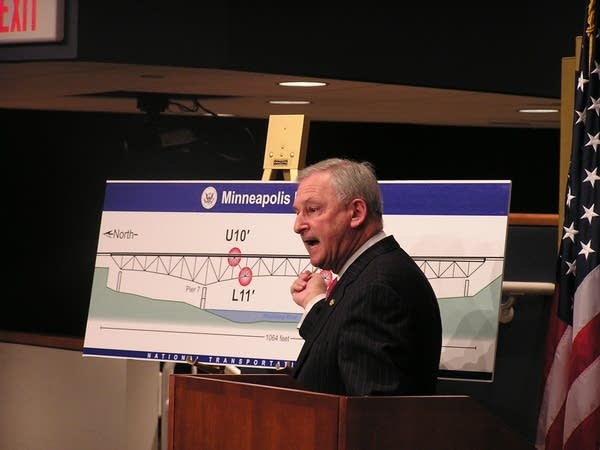Bridge investigation: Six months of digging but few answers
Go Deeper.
Create an account or log in to save stories.
Like this?
Thanks for liking this story! We have added it to a list of your favorite stories.

Former NTSB Chairman Jim Hall says a public hearing should be called on the collapse to clear up some of the public confusion, and rumors of politics in the board's investigation.
Hall made the remarks after a dustup between U.S. Rep. Jim Oberstar, D-Minn., and current board chair Mark Rosenker. The flap was over comments Rosenker made in a Jan. 15 news conference about the bridge investigation.

The NTSB called the news conference to announce a design flaw found in the 35W's gusset plates. A set of the plates near the southern end of the bridge were too thin. Rosenker suggested other bridge owners inspect gusset plates before doing any major repairs or expansions on their bridges.
But Rosenker went further, saying that state inspectors would not have found this design flaw, and that weak gusset plates were so unheard of that investigators were "shocked" by the finding.
Turn Up Your Support
MPR News helps you turn down the noise and build shared understanding. Turn up your support for this public resource and keep trusted journalism accessible to all.
"We have no reason to believe at this time that that played a role in the failure of the gusset plates, or the rest of the bridge," Rosenker said at the time.
The investigation is still in the fact-finding stage which began six months ago, according to one high-level NTSB investigator who spoke on background. That means the analysis to determine the primary and secondary causes of the collapse has not begun yet.
Shortly after the news conference, Oberstar wrote to Rosenker, complaining that Rosenker's remarks could compromise the board's investigation and findings, because no analysis had been completed.

"This means that the board has not yet determined the role played by poor design of the gusset plates in causing the accident," Oberstar wrote.
Sources close to the board agreed with Oberstar's assessment, but were reluctant to go on record. Former chair Jim Hall said while he was not keeping up to date on the investigation, he did agree with Oberstar's letter.
"Any confusion in this regard would be eliminated by the board having a public hearing on the cause of this collapse," said Hall. "And I think it would be unusual for the board not to have a public hearing."
A public hearing would bring many of the facts of the case, and the questions NTSB board members have, to the public. To date, no hearing has been scheduled. And in fact, the NTSB has not held a public hearing on any investigation since August 2006.
Hall said this board tends not to hold hearings, even though part of the board's mission is to build public awareness.

An NTSB spokesperson said the board hasn't decided whether to call a hearing on the 35W bridge collapse.
In his January news conference, Rosenker largely ruled out corrosion as a possible contributing cause of the collapse. But in his letter to Oberstar, Rosenker seemed to back away from his original statements.
"Although bridge inspection records did identify some areas of cracking and corrosion on the bridge, at this point in the investigation -- and I emphasize, at this point -- NTSB investigators found no evidence of corrosion in the gusset plates at nodes U10," he wrote to Oberstar.
MnDOT investigators found corrosion at several nodes, or connection points, where steel members and gusset plates join. Gussets and members were corroded at nodes nine, 11, 12 and 13.
Inspectors also noted concern about tack welds and loose bolts at U10 and U7. Fatigue cracks were found in spans three through five and nine and 10.
Rosenker's statements have raised questions about the investigation for structural engineer Hassan Astaneh. Astaneh is a professor at University of California, Berkeley and an expert in gusset plates.
"I'm beginning to really feel like we should get more information. They should provide more information to the public before they make such a strong statement [about the cause of the bridge collapse]," Astaneh says.
Astaneh says he is also surprised at Rosenker's assertion that bridge inspections by MnDOT and its contractors wouldn't have found the underdesigned plates.
That is the case during routine inspections, but Astaneh says a bridge should undergo more rigorous scrutiny before it is subject to major construction or expansion. The 35W bridge was undergoing some major repair work at the time of the collapse.
"Inspection of a bridge, especially if you are doing construction on it -- is not just going to be field inspection and checking the fatigue and corrosion. Inspection means you look at the whole system and analyze it," Astaneh says. "That's why MnDOT paid URS to do such analysis before undertaking the current construction."
Minnesota Public Radio news posed questions about the inspection to MnDOT spokeswoman Lucy Kender. In response to e-mail questions, Kender said gusset plates would not typically be part of the computer analysis on the truss members.
Kender also wrote that MnDOT had no knowledge of a gusset plate failure in any similarly designed bridge. Nor did it know whether any other states' transportation departments had looked at gusset plates as part of standard inspection prior to major renovations.
At least one bridge similar to the I-35W bridge did fail due to under-designed gusset plates. In 1996, an interstate bridge over the Grand River in Ohio fell two inches on one side after gusset plates buckled. The plates were too thin and corrosion further weakened the plates.
The bridge failed while construction workers were sanding off rust on the plates.




